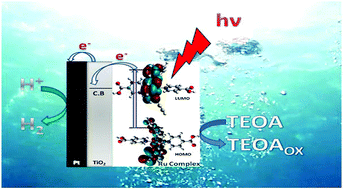In this work, two new bis-(hydroxyphenyl)bipyridine based ruthenium complexes with 4-picoline (coded as MCS-B4M) and isonicotinic acid (coded as MCS-B5M), which act as ancillary ligands, have been synthesized and employed for the first time as photosensitizers in photocatalytic hydrogen evolution studies. The photocatalyst MCS-B5M/TiO2–Pt showed an impressive hydrogen generation rate of up to 4.2 mmol h−1 and turnover number (TON) of 84 959 after 5 h. The better performance of B5TP over B4TP was due to the higher excited state lifetime of MCS-B5M (∼2.6 ns) than that of MCS-B4M (∼1.4 ns). This leads to a higher probability of electron transfer to the TiO2/Pt composite in the case of the former and a stronger coupling of MCS-B5M excited states with the conduction band of the TiO2/Pt composite by the –COOH linkers of the isonicotinic acid moiety, resulting in better photosensitization as observed in the UV-Vis (DRS mode) absorbance study. The comparative study of the two dyes clearly shows the manifestations of their respective ancillary ligands having contrasting electronic properties. This work gives a new class of ruthenium photosensitizers as efficient light harvesting photocatalysts.

